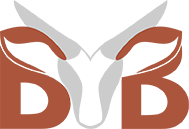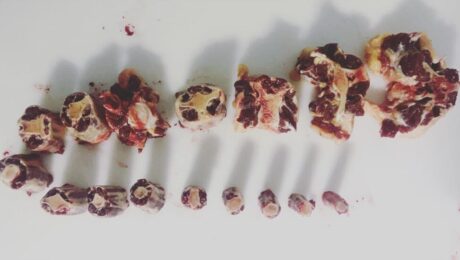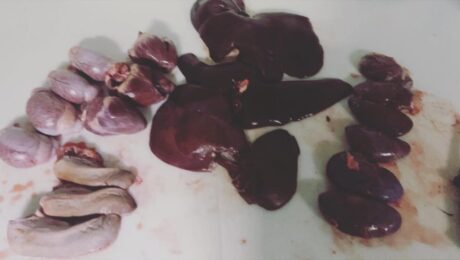It’s officially soup weather in Oklahoma!


Which means it is this cut’s moment to shine- The Oxtail.

Oxtail is simply the tail from cattle. Back in the day, oxtail came from the tail of an “Ox” i.e., a male, steer, trained to work on the farm, hence the name Oxtail. It is now sourced from either sex, because, equal rights and all.


I like to cut oxtail into 2” long oval portions, which is an ideal size for braising and slow cooking to cook the meat, but also an ideal size to maximize the release of the bone marrow, fats, and gelatinous collagen.

I would LOVE to see your favorite ways to cook oxtail in the comments!

- Published in Uncategorized
Stew Meat: Where does it come from?

When you’re filling out a cut sheet for beef, you’ll almost always come across this as an option. It is an option on my own cut sheet as well.
‘Stew Meat’ is typically cut out of the round or the chuck, but can be cut from just about any roast section of the animal. That being said, if you run out of Stew Meat, and you’re swimming in roasts, pull out one of those roasts and cut it into stew appropriate sized pieces and you’re back in business.
- Published in Uncategorized
All About Organ Meat
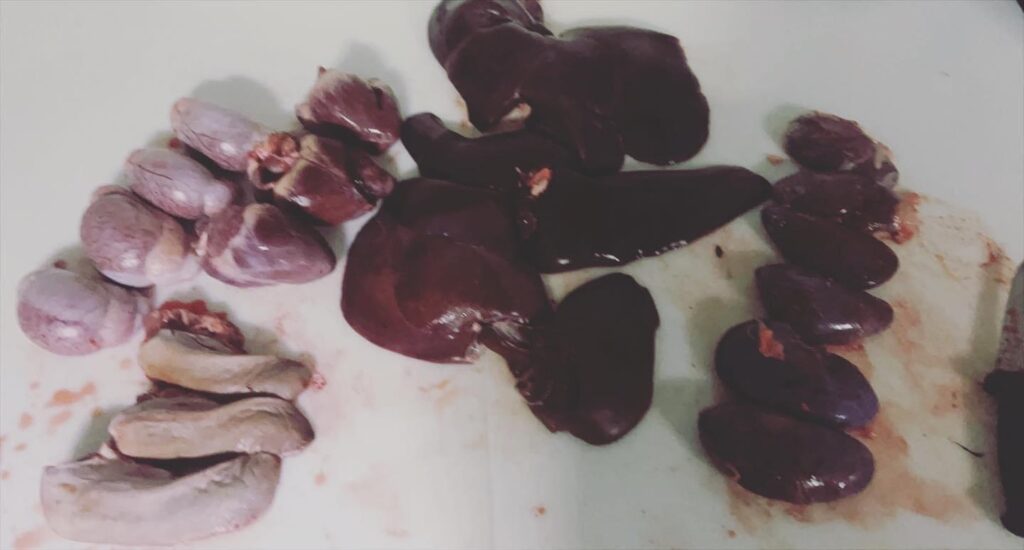

ORGAN MEATS

Left to Right:

Manly Bits: These nuts are loaded with protein, vitamin B, selenium, and zinc.

Heart: The heart is rich in folate, iron, zinc, and selenium. It is also a great source of vitamins B2, B6, and B12, all three of which are in a group known as B-complex vitamins.

Tongue: Tongue meat is rich in calories and fatty acids, as well as zinc, iron, choline, and vitamin B12. *Incredibly healthy for women who are pregnant or want to become pregnant!


Liver: Liver is the most nutrient dense organ meat, and it is a powerful source of vitamin A.

Kidney: Rich in nutrients and proteins, kidney meat contains omega 3 fatty acids. It is also known to contain anti-inflammatory properties and to be good for the heart.
- Published in Uncategorized
KECO 96.5 Radio Apperance
Jimmy Clark invited me to be on his show, Today in Ag, on KECO 96.5
- Published in Uncategorized
Mobile Backyard Butcher w/ Tiffany Permaculture P.I.M.P.cast
- Published in Uncategorized
Butcher Roundtable
Join Josh and a whole crew on the Renegade Butcher show at 6pm Central, Tuesday 6/13 for a special round-table discussion with 4 butchers! We’re going to discuss the challenges and rewards of our journeys in small scale and mobile butchery, as well as answer your questions! Be sure to jump on the Telegram group, or message Josh on Nostr if you have any questions to submit before the show. Along with Josh, we will have: Tiffany Baxter of Backyard Butchery and Freeland Farms returning to the show. Tiffany operates a well-made mobile processing trailer in South-Central Oklahoma, as well as being a homesteader, avid beekeeper and apiary specialist. She can be found all over social media as Backyard Butchery. Kyle Perreault owns and operates The Bodyshop: Custom Butchering & Euro Taxidermy in New Hampshire, as well as running the Meat The Critters podcast and Livestream. @backwoodsbutcher603 on Youtube, Facebook, Instagram and Tiktok @backwoodsbutcher603 Nostr npub19dhdrmp65960qzysmc8x60d0jatfm9etj5tca0sfju4vurxp7ayswxr00n Telegram: https://t.me/+k_eCjrNwnpc0N2Jh Joseph Blakeslee from Blakeslee Acres in South Western NY raises pastured beef and pork and is currently builing his own custom exempt butcher shop after learning the trade. Follow Joseph on Facebook and Youtube @blakesleeacres Value for value: ⚡️[email protected] https://renegadebutcher.ittybitty.tips
- Published in Uncategorized
BUTCHER PODCAST ALERT: THE RENEGADE BUTCHER
Welcome, food enthusiasts and meat lovers, to a remarkable episode of the Renegade Butcher Podcast! Today, we embark on a gastronomic journey with the illustrious Tiffany Baxter, a true maestro of the culinary world and an undisputed expert in the art of butchery. Her passion, dedication, and extraordinary experiences make her the perfect guest speaker for this episode, promising to leave us all inspired and hungry for more.
One of the most compelling aspects of Tiffany Baxter’s culinary philosophy is her unwavering commitment to sustainable and ethical agricultural practices. With growing concerns about the environmental impact of agriculture, she has emerged as an advocate for responsible sourcing and conscious consumption and regenerative agriculture.
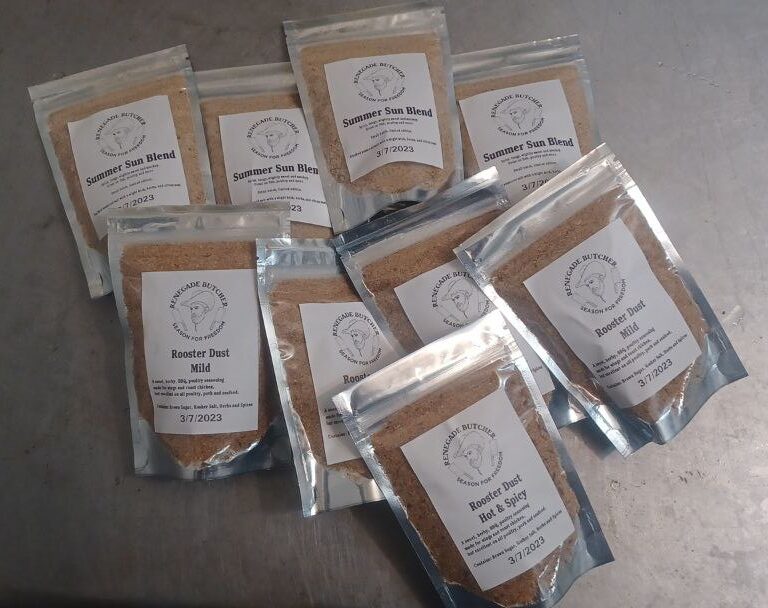
Josh, The Renegade Butcher, has his own line of seasonings you can also check out by visiting his site, (link below).
Josh grew up in the midwest with an ever-growing passion for cooking and food in general. Making his way to Texas nearly a decade ago, he added craft butchery and charcuterie as well as Texas style barbecue to his list of culinary obsessions. Eventually starting his own series of small businesses in an effort to help ease the pressure on small processors caused by the events in 2020. Not only has he been working to teach small ranchers and homesteaders how to process their own livestock in person, he runs a video/audio podcast, has built an active online community and has launched a much anticipated line of seasoning blends based on his own personal recipes. His blends have been well received by his wild game customers, and his sausage products are in demand every fall with local hunters.
You can check them out at:
- Published in Uncategorized
PODCAST ALERT!
RED HILLS RANCHER invited me to be on his podcast. Catch it here: https://open.spotify.com/episode/2JO3n3zi04OFRBC1AxikxS…
- Published in Uncategorized
GROCERY STORE MEAT -PT 2
Now we know that we don’t actually know where our grocery store beef is coming from let’s talk about what we *do* know.
So how are the cattle raised in the US that end up in grocery stores?
The answer is CAFO’s, or Concentrated Animal Feed Operstion’s. Aka Factory Farms.
At factory farms, animals raised for food suffer unimaginable cruelties and extreme confinement. Most factory-farmed cows never get to step foot outside during their production years, confined instead to indoor sheds that are often filthy and crowded. They’re denied the ability to graze, lie comfortably, nurse their young, or live in socially complex herds.
Cows were born to eat grass—not grains or corn. When CAFO cows are forced to eat foods that they weren’t designed to eat, things start to look pretty bleak. Sickness and nutrient deficiencies run rampant in these cows–the factories expect this, which is why massive amounts of antibiotics are kept on hand (the feed for these cows contains about 0.25 pounds of antibiotic per 15 to 20 pounds of feed1).
Antibiotics wreak havoc on the gut flora of these cows, and then do the same to you when you eat the various cuts of meat. Without healthy gut flora, dangerous strains of bacteria flourish, digestion is impaired, and deficiencies in important nutrients arise.
Because CAFO’s house so many animals in such a small space, CAFO’s produce huge amounts of animal sewage and other pollutants.
CAFO owners and operators spend millions of dollars on technologies that make it possible to produce massive quantities of milk, eggs, and meat, yet they resist investing in technologies and practices to properly treat the wastes that are by-products of this industry.
-The amount of urine and feces produced by the smallest CAFO is equivalent to the quantity of urine and feces produced by 16,000 humans. CAFO waste is usually not treated to reduce disease-causing pathogens, nor to remove chemicals, pharmaceuticals, heavy metals, or other pollutants.
-Over 168 gases are emitted from CAFO waste, including hazardous chemicals such as ammonia, hydrogen sulfide, and methane.
-Airborne particulate matter is found near CAFO’s and can carry disease-causing bacteria, fungus, or other pathogens.
-Animals frequently die in CAFO’s. Their carcasses, often in large numbers, must be dealt with.
-Infestations of flies, rats, and other vermin are commonplace around CAFO’s and therefore around CAFO neighbors.
Did I mention these factory farms run on government subsidiaries?
CAFO’s can’t survive without taxpayer subsidies. CAFO’s receive many subsidies, such as milk price support guarantees, federal EQIP money through the Farm Bill, Development Right Agreements, tax abatements, grants, bonds, even economic development funds for roads.
These taxpayer supports not only encourage the growth of this industry, they undercut the ability of traditional livestock operations to compete with CAFO’s. Without the subsidies, CAFO’s would fail financially.
- Published in Uncategorized
THE GROCERY STORE MEAT SAGA – PT 1
OK I’ve been carefully avoiding this post, but it seems to be making it’s rounds so I am going to address it today. It will require more than one post and I’m probably going to hurt some feelings, so buckle up.
OK let’s talk about it… grocery store ground beef; Part 1.
Where does it come from?
In 2016, 4 industrial beef companies — who control over 80% of the beef market in the United States — successfully lobbied to remove the Country of Origin Labeling requirements from packaging. In plain English, this means that beef and pork sellers in the United States aren’t even required to tell you what country the beef and pork you buy came from.
Here’s the problem. Everyone selling meat uses stock art photos of small farms and says things like “thoughtfully sourced,” “farm fresh” and “we work with family farms in the USA” — even if the vast majority of the meat they sell is, in fact, raised overseas in factory-like conditions, in desert climates where natural grasses don’t grow, using inferior breeds eating low-quality grass pellets, before being shipped to the USA at industrial scale. Meat from a meat broker.
Adding insult to injury, it’s maddening to discover that, in fact, beef from cattle which were born, raised and slaughtered overseas, can legally be labeled as “Product of USA,” as long as the final step of slicing into steaks and packaging happens in the states.
Such cattle are trucked from “cow/calf operations” to massive, concentrated feedlots where all traceability back to the ranch is lost. By the time it’s been processed at scale, packaged, sorted and distributed through brokers, nobody has any idea where it was from in the first place.
Retailers aren’t required to even tell you what country your beef is from.
Even at high-end grocery stores, the person behind the meat counter typically can’t tell you which farm(s) the meat came from — let alone what country it came from. The added complexity and cost of such traceability is exactly why industry lobbied to remove Country of Origin Label requirements in the first place.
Prior to this, one pound packs of Costco organic ground beef used to list no fewer than 5 countries… on a single pound of ground beef. Think about that.
This is insane. We deserve better.
- Published in Uncategorized
- 1
- 2
